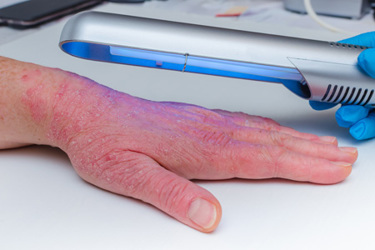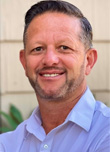Phototherapy Devices: Where Is The Field Headed?
By Patrick Reichert, Zerigo Health

Nearly one in 10 people suffer from a chronic skin condition, including psoriasis and eczema, and phototherapy is clinically proven to significantly reduce symptoms such as inflammation and itching skin. Patients with mild cases of psoriasis or eczema (atopic dermatitis) may get satisfactory results with the use of topical treatments. However, as the severity of the condition increases, topicals are often insufficient, which drives the need for alternative options. More recently, systemic and biologic treatments have found widespread use among these patients, albeit at a staggering cost of as much as $65,000 annually. Furthermore, according to data from the National Institutes of Health, these medications come with risks of systemic side effects and immunosuppression that many patients are not willing to assume.
Hence, patients living with these chronic skin conditions are increasingly turning to light-based therapy – known as phototherapy – as an alternative to topicals or biologics. In fact, the “worldwide global light therapy market size is expected to reach $2.10 billion by 2030”.
Different Wavelengths Of Ultraviolet (UV) Light Used To Treat Psoriasis And Eczema
Several phototherapy treatments operating in the UVA, UVB, and narrowband UVB (NB-UVB) wavelengths are available for patients with psoriasis and eczema. All of these sources have shown clinical efficacy, and it’s important for patients to understand the differences and benefits of each type when deciding on a treatment plan.
UVA: This light source ranges from 315 to 400 nanometers (nm), the unit of measure for light wavelengths equal to one billionth of a meter. UVA is often used in conjunction with the plant-based substance psoralen, which is activated by the UVA light. This form of phototherapy is commonly referred to as PUVA. Clinical studies have shown positive results, but when compared to NB-UVB (see below), PUVA was found to cause a higher rate of adverse effects such as symptomatic erythema and blistering.
UVB: Also referred to as broadband UVB (BB-UVB), this light ranges from 280 to 315 nm and is an older form of phototherapy than NB-UVB. UVB is generally only used for the treatment of psoriasis and eczema if NB-UVB is not available.
NB-UVB: This refers to a selective portion of the UVB spectrum in the range of 311 to 313 nm. In the early 1980s it was observed that wavelengths around 311 nm were more effective than BB-UVB sources, which led to the development of narrowband fluorescent lamps and LED systems. Narrowband UVB phototherapy has since become the most frequently used form of phototherapy to treat psoriasis and eczema. More than 25 years of clinical data shows NB-UVB phototherapy to be one of the safest and most effective treatments for the symptoms of eczema and psoriasis. This type of therapy involves exposing skin to targeted wavelengths for a prescribed amount of time.
Why Consistency Matters
According to the National Psoriasis Foundation, consistency, also referred to as adherence, is key in finding success with phototherapy. By adhering to a consistent phototherapy treatment plan, patients may find relief for symptoms caused by chronic skin conditions, like eczema and psoriasis. Treatment is typically administered two to three times per week, with a gradual increase in exposure time to avoid potential side effects like erythema (superficial reddening to very mild “burns” or skin irritation). However, with the majority of phototherapy systems residing in physicians’ offices and clinics, patients must schedule appointments, juggle their personal and work schedules around clinic hours, and arrange travel to and from the clinic. The difficulty in coordinating these activities is the primary reason that the majority of patients receiving phototherapy have trouble adhering to the treatment regimen.
How Can Recent Advances In UVB Light Sources Be Used To Develop Devices That Are More Effective?
Improvements in reliability and performance and decreases in the cost of UVB LEDs, compact narrowband UVB lamps, and monochromatic lamps are providing medical device engineers with more effective light sources that are enabling successful home-use systems.
The size of UVB LEDs, measuring approximately 1 mm square, allows engineers to design compact two-dimensional arrays of LEDs to tailor the optical power and illumination uniformity required for compact, battery-powered, handheld devices. The lifetime of LEDs is in the range of thousands of hours, which is roughly 10 to 15 times that of lamp systems. LED systems are best suited for spot treatments of mild to moderate skin conditions like psoriasis and eczema affecting approximately 0.5%-5% of the body. The compactness and battery power source of these designs make them highly portable and attractive to patients who need the freedom to treat their skin condition anytime and anywhere. Advanced high-power LED systems generally outperform handheld lamp systems due to the higher irradiance at the treatment plane of the LED systems, which reduces the treatment time for any given treatment dose.
The development of high-intensity narrowband UVB lamps and, more recently, 308-nm excimer lamps, is enabling their use in a variety of home-use designs ranging from handheld devices to midsize panels. Midsize panels using high-intensity narrowband UVB lamps provide reasonable portability while allowing the treatment of relatively large body areas like the back and torso. These types of panels are well suited for skin conditions such as psoriasis and eczema that are considered moderate to severe and affect over 5% of the body area, especially if the affected body areas are contiguous. The lifetime of the lamps used in these types of systems is in the order of a hundred to a few hundred hours, after which the user must replace them.
The 308-nm excimer lamp is unique in that it has the same wavelength as the 308-nm excimer laser, which is widely used by physicians to treat psoriasis and vitiligo. However, this is where the similarities end. The primary advantages of the laser system are that the light energy is delivered through a small light guide generally smaller than a psoriasis lesion and the irradiance is very high. This makes the laser system a very “targeted” system, allowing only the lesions to be treated, while avoiding healthy skin from being exposed to the UV light energy, thus reducing carcinogenesis and photoaging. Furthermore, the high irradiance of the laser system allows for rapid dose deposition and some studies suggest that the high irradiance of the laser system results in clearance in a lower cumulative dose when compared to treatment with traditional NB-UVB phototherapy. Since such a laser system is precluded from the home use market, engineers are turning to the 308-nm lamp source to design handheld home use devices for psoriasis and eczema treatments. The irradiance of a 308-nm lamp system is significantly less than a 308-nm laser system, and it does not have the same ability to “target” when compared to the laser system. The complexity and size of the high-voltage power source needed to operate the lamp, the cooling system for the lamp, and the reflective housing to project the light to the treatment area require the system to be plugged into an AC outlet and generally result in a larger and much heavier device when compared to a similar performing LED device.
Manufacturers at the cutting edge of home-use phototherapy systems are coupling their devices with cloud-based smart applications, which use data to optimize the patient experience and improve adherence. Instead of having to go to a dermatologist’s office multiple times per week, home UVB systems allow patients to treat themselves in privacy and on their schedule. This paradigm shift has increased patient adherence and their subsequent success with phototherapy.
About The Author:
 Patrick Reichert is the senior director of hardware engineering at Zerigo Health, where he leads the research and development team developing Zerigo’s smart phototherapy products. He has more than 35 years of experience working with a variety of gas, solid-state, and semiconductor lasers and light sources. He started his career at Lawrence Livermore National Laboratory, where he was a key contributor to applied research experiments in space-based laser defense systems and the development of diode-pumped solid-state lasers. Reichert’s private sector career spans the last 25 years in roles in the design, development, and commercialization of home-use and physician-use products employing semiconductor lasers and LED light engines. Prior to Zerigo Health, he worked at Lumenis and TriaBeauty.
Patrick Reichert is the senior director of hardware engineering at Zerigo Health, where he leads the research and development team developing Zerigo’s smart phototherapy products. He has more than 35 years of experience working with a variety of gas, solid-state, and semiconductor lasers and light sources. He started his career at Lawrence Livermore National Laboratory, where he was a key contributor to applied research experiments in space-based laser defense systems and the development of diode-pumped solid-state lasers. Reichert’s private sector career spans the last 25 years in roles in the design, development, and commercialization of home-use and physician-use products employing semiconductor lasers and LED light engines. Prior to Zerigo Health, he worked at Lumenis and TriaBeauty.
